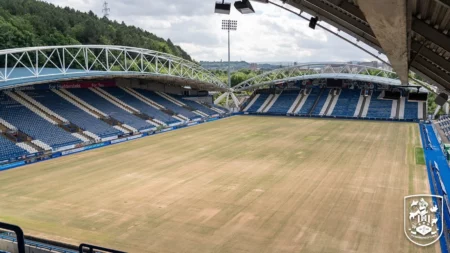Aitkens has been hailed as an integral part of the pitch rejuvenation at Tadcaster Albion Football Club, after the surface lay under water for 10 weeks, with initial flooding in December seeing water rising over the height of the crossbar.
Tadcaster AFC were unable to play at the i2i Stadium until February 13 as head groundskeeper David Wakefield tried to salvage what was an impressive pitch from weeks of flooding, which started at the end of 2015.
With the help of Aitkens’ Paul Emmanuel and the company’s range of products there was only a 73-day wait for soccer to return to the stadium. As Wakefield explains, “Paul was second-to-none for advice and support. All the staff at Aitkens, from Richard Aitken to the delivery drivers and the lads in the warehouse, were great with us, and the level of customer service we received was fantastic, they really were truly helpful.”
“We were at a stage where the grass had literally died, so we had to compose a plan that would help us get the surface back, but we were conscious of not going for any quick fixes.
“Paul’s initial thoughts were that we needed to get some grass growing, so went for the Award Nutri-Pro 16-2-10 fertilizer, and even though it’s not the ideal time of year to apply it, the results were great.
“I also used Terralift Rocastem and Quadrop when we were eventually able to spray, which helped to help revitalize the root zone.
“We also used Award Surf To Turf Seaweed, and the color we got out of it was tremendous, but the important thing is the longevity – it’s a lot better than some others that I’ve seen. And that goes back to the time they take in sourcing the products, which keeps enhancing the nutrients in the soil.”
Wakefield was already a customer of Aitkens, and believes that the time spent in developing organic products helped to develop a very strong soil and root zone – through Rocastem, Award Surf To Turf and Quadrop – and because of this, recovering the pitch was made that bit easier.
“The flooding happened on December 26 and the water was over the cross bar,” Wakefield adds. “The pitch sat under around 3-4ft of water for two or three days until it started to recede, then we were able to get in and start pumping it off.
“We had a lot of rubbish to clear off the site, such as boards, fencing and sheds that had floated in, but it was so wet it was like walking through a bog – you’d be leaving footprints as you walked.
“It was six weeks until we were able to get onto the pitch, but it was under water in some areas for nine weeks because of a drain around the back of the stand, so it wasn’t until February that we had a completely dry surface.”
May 19, 2016





